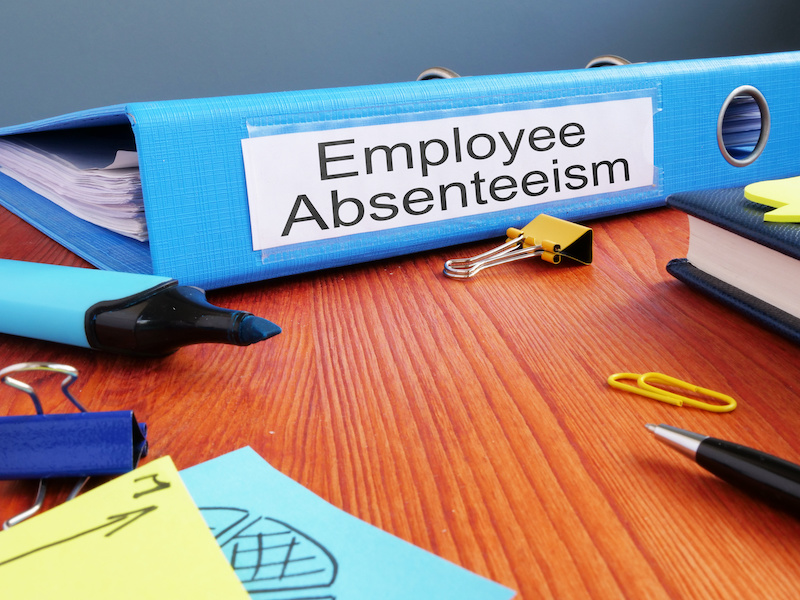Employee absenteeism is a pressing concern for companies of all sizes and industries. It refers to employees’ frequent or unplanned absences from work. In today’s dynamic and competitive markets, a company’s success largely depends on the dedication and involvement of its employees. When absenteeism becomes a chronic problem, it can adversely affect a business’s productivity, efficiency, and overall company culture. Absenteeism can disrupt a company’s daily operations, leading to project delays, reduced customer satisfaction, and increased workloads for remaining employees. This can lead to lower productivity levels, hindering a company’s ability to achieve its goals and objectives. Furthermore, frequent absenteeism can strain team dynamics, as colleagues may become frustrated with their additional responsibilities due to absent team members. This can reduce morale and have a negative impact on the company’s culture. This article reviews the common reasons for employee absenteeism and how employers can combat it.
What Is Employee Absenteeism?
Absenteeism is a term used in the workforce to describe an employee’s habitual or unscheduled absence from work during their scheduled work hours. This can be due to a variety of reasons, ranging from legitimate causes such as illness, family emergencies, or personal issues to unauthorized or unexcused leave. Absenteeism can be classified into two primary types: planned and unplanned. Planned absenteeism is when an employee takes scheduled time off, such as vacation days or pre-approved leaves. In contrast, unplanned absenteeism is when the employee takes unanticipated absences that can disrupt the work schedule.
What Constitutes Excessive Absenteeism?
Excessive absenteeism is typically defined as an employee missing work beyond an acceptable threshold, often without valid justification. While the specific number of days varies by company policy and industry standards, many organizations consider more than five to ten unexcused absences in a year to be excessive. In cases where absenteeism disrupts productivity or violates attendance policies, employers may implement disciplinary actions or require interventions such as performance reviews or medical documentation. Addressing absenteeism proactively helps maintain departmental workflows and productivity.
Types of Employee Absenteeism
Employee absenteeism can be categorized into four main types, each with different causes and implications for workplace productivity. Understanding these distinctions can help organizations manage absenteeism appropriately while supporting employees’ needs.
1. Innocent absenteeism
Innocent absenteeism refers to absences that occur due to reasons beyond the employee’s control. These typically include health-related issues such as illnesses, injuries, or family emergencies. Since these absences are often unavoidable, employers usually handle them with policies that provide sick leave or medical accommodations. However, excessive innocent absenteeism may require intervention, such as wellness programs or return-to-work strategies, or offering the employee a flexible schedule temporarily.
2. Culpable absenteeism
Culpable absenteeism occurs when an employee is absent without a valid reason or fails to follow the company’s attendance policies. Examples include skipping work without notice, providing false excuses, or frequently calling in sick when not genuinely ill. Since culpable absenteeism is within the employee’s control, it can lead to disciplinary actions, including warnings, probation, or termination if the behavior persists. Employers often address this type of absenteeism through clear policies, attendance tracking, and performance management strategies.
3. Authorized absenteeism
Authorized absenteeism includes planned and approved absences, such as vacations, personal days, and leaves of absence. These absences do not negatively impact the organization as long as they are scheduled in advance and managed properly. Many companies offer paid time off (PTO) or flexible leave policies to ensure employees can take necessary breaks without disrupting workflow. Maintaining a fair and transparent leave policy helps create a positive work environment while reducing unplanned absences.
4. Unscheduled absenteeism
Unscheduled absenteeism occurs when employees miss work without prior notice, often due to unexpected events like sudden illness, childcare emergencies, or transportation issues. While some cases are unavoidable, frequent unscheduled absences can disrupt business operations and increase workload for other employees. Organizations can mitigate this issue by offering flexible work arrangements, remote work options, or contingency plans to handle unexpected absences efficiently.
5 Reasons Why Employees Experience Absenteeism in the Workplace
1. Time theft
Time theft is a workplace issue that occurs when employees misuse their work hours by engaging in non-work-related activities or by extending their scheduled breaks and lunch hours without permission. These unauthorized breaks and extended lunch hours can disrupt productivity, leading to incomplete tasks and missed deadlines. It can also create added stress for both the employee involved and their colleagues, causing a disruption in workflow. This disruption may force employees to take time off to catch up on their work or address the stress and pressure resulting from uncompleted tasks, which in turn can contribute to absenteeism.
2. Lack of flexible schedule
The lack of a flexible schedule is a common workplace challenge that can significantly contribute to absenteeism issues. When work hours are rigid and inflexible, employees often find it challenging to balance their professional obligations with their personal lives, resulting in several practical problems.
Employees with fixed work schedules may have difficulties attending to personal matters such as medical appointments, family emergencies, or childcare responsibilities. These obligations may require them to take unplanned time off, leading to absenteeism.
Inflexible schedules can also contribute to heightened stress levels among employees. The constant struggle to balance work and personal life without flexibility can lead to burnout, anxiety, and other mental health issues.
3. Family and personal responsibilities
Family and personal obligations are major contributing factors to absenteeism in the workplace. Employees often face situations where their family demands and personal commitments clash with their work responsibilities, resulting in unplanned absences.
For instance, an employee may need to take time off to care for a sick child or attend to the medical needs of an elderly family member. Similarly, personal obligations such as medical appointments, unforeseen emergencies, or the need to relocate can disrupt an employee’s regular work schedule and lead to absenteeism.
4. Inadequate policies or benefits
Inadequate policies or benefits within a company can significantly contribute to absenteeism among employees. When organizations fail to provide essential policies and benefits, it stresses their workforce and hinders their ability to effectively manage personal and health-related needs.
For example, the absence of flexible work arrangements can force employees into a one-size-fits-all schedule that doesn’t consider their unique circumstances. Similarly, inadequate healthcare benefits can discourage employees from seeking timely medical care and/or services from mental health professionals, resulting in longer recovery times and increased absenteeism when health issues become more severe.
5. Stress and burnout
Stress and burnout are pervasive in today’s fast-paced and demanding work environments. When employees grapple with high levels of stress and burnout, it can lead to increased absenteeism. These problems can arise due to the constant pressure to meet deadlines, perform at peak levels, and manage heavy workloads. This persistent strain can negatively impact employees’ mental and physical health, requiring them to take time off to recover.
5 Ways to Combat Employee Absenteeism in the Workplace
1. Flexible work arrangements
Fostering flexible work arrangements has become increasingly crucial in modern workplaces, offering numerous benefits for both employees and employers. These arrangements encompass a variety of options, including flexible work schedules, remote work opportunities, and compressed work weeks.
Flexible work schedules allow employees to adapt their working hours to better suit their individual needs and responsibilities. Remote work options, on the other hand, provide employees with the freedom to work from locations beyond the traditional office setting. This promotes work-life balance and reduces commute-related stress and expenses, potentially boosting job satisfaction and productivity. There are many ways to build a strong company culture with a remote team, so this arrangement becomes a win-win situation for everyone involved. Additionally, these options can help organizations retain top talent, reduce absenteeism, and increase employee engagement while minimizing real estate costs and improving the bottom line.
2. Employee Assistance Programs (EAPs)
Employee Assistance Programs (EAPs) are valuable resources that organizations can provide for their employees to address various personal and mental health issues. These programs play a crucial role in reducing absenteeism and promoting a healthier work environment.
Firstly, EAPs offer confidential and accessible support to employees who face personal challenges such as financial difficulties, relationship problems, substance abuse, or other life stressors. By providing a safe and non-judgmental space to discuss these issues, employees are more likely to seek help proactively, thus reducing the negative impact on their well-being and job performance.
3. Clear attendance policy
Having a clear attendance policy is critical to maintaining a well-functioning and accountable workforce. It covers the company’s expectations regarding punctuality, regular attendance, and the procedure for requesting time off. When these policies are well-defined and communicated, employees can easily comprehend what is expected of them, which decreases the likelihood of misunderstandings or unintentional breaches.
Furthermore, transparent attendance policies encourage fairness and consistency in handling attendance-related matters. When all employees are held to the same standards, it eliminates any feelings of favoritism or unfair treatment, leading to a more harmonious work environment.
4. Wellness programs
Organizations can take a proactive and effective approach to promoting employee well-being and preventing burnout by implementing wellness programs. These programs can include a variety of initiatives such as fitness facilities, stress management workshops, and holistic health interventions aimed at improving physical and mental health. Providing access to wellness programs sends a clear message to employees that their organization values their well-being. This can lead to an increase in morale, job satisfaction, and overall engagement.
5. Recognition and rewards
Recognition and rewards play a pivotal role in boosting employee morale, job satisfaction, and overall motivation, thereby reducing the likelihood of absenteeism within an organization. When employees feel appreciated and valued for their hard work and contributions, it fosters a sense of belonging and engagement.
Moreover, recognition and rewards programs can foster a competitive yet healthy work environment where employees are motivated to excel. By setting clear performance benchmarks and acknowledging achievements, organizations can stimulate a culture of continuous improvement. This encouraging culture can deter absenteeism as employees are motivated to maintain their performance levels and earn recognition.
Conclusion
Absenteeism in the workplace is a multifaceted issue that can have significant and long-lasting consequences for a company. It is crucial to identify the underlying causes and implement effective strategies to address absenteeism to maintain a productive and positive work environment. Taking proactive measures such as offering flexible work arrangements and fostering a culture of work-life balance can help reduce absenteeism, improve employee satisfaction, and ultimately enhance the company’s overall performance and profitability. In every stage of the employee lifecycle, INTOO helps employers protect their brand through effective candidate experience, career development, and outplacement services. Contact us to learn how we can make a difference for you and your employees.













